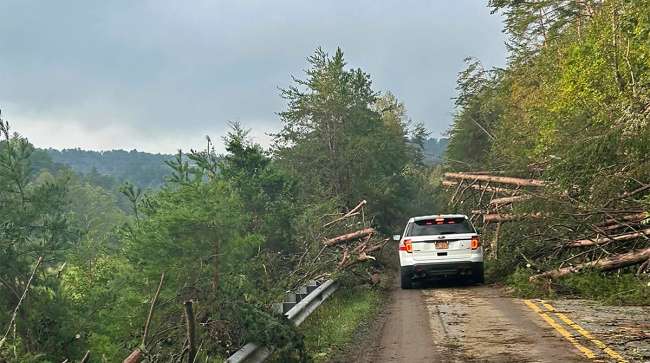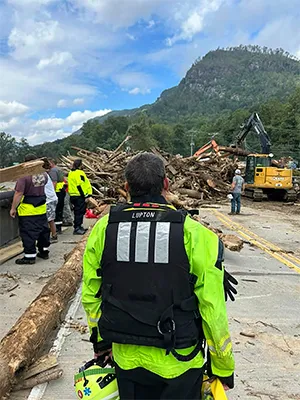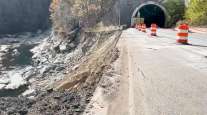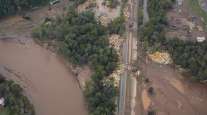Supplies Rushed to Communities Isolated by Helene

[Stay on top of transportation news: Get TTNews in your inbox.]
ASHEVILLE, N.C. — A crisis unfolded in western North Carolina as officials rushed to get more water, food and other supplies to flood-stricken areas without power and cellular service Sept. 30, three days after Hurricane Helene ripped across the U.S. Southeast. The death toll from the storm has reached 107.
Georgia Gov. Brian Kemp said during a news conference Sept. 30 that the death toll in that state had risen from 17 to 25. More than half of all fatalities have been reported in the Carolinas. A North Carolina county that includes the mountain city of Asheville reported 30 people killed.
Gov. Roy Cooper predicted the toll would rise as rescuers and other emergency workers reached areas isolated by collapsed roads, failing infrastructure and widespread flooding.
Supplies were being airlifted to the region around the isolated city of Asheville. Buncombe County Manager Avril Pinder pledged that she would have food and water to the city by Sept. 30.
Leave roads in western NC open for emergency vehicles and rescue crews. https://t.co/GpOQxLsMRS — NC Emergency Management (@NCEmergency) September 28, 2024
“We hear you. We need food and we need water,” Pinder said on a Sept. 29 call with reporters. “My staff has been making every request possible to the state for support and we’ve been working with every single organization that has reached out. What I promise you is that we are very close.”
Asheville’s water system was severely damaged. Residents walked with buckets to a creek to get water to flush toilets, carefully watching their steps where a wall of water three days before ripped away all of the trees and ground, leaving only mud.
Neighbors shared food and water and comforted each other. “That’s the blessing so far in this,” Sommerville Johnston said outside her home.
Officials warned that rebuilding from the widespread loss of homes and property would be lengthy and difficult. The storm upended life throughout the Southeast. Deaths also were reported in Florida, Georgia, South Carolina and Virginia.
Federal Emergency Management Agency officials said Sept. 30 that hundreds of roads were closed across western North Carolina and that shelters across the area were housing more than 1,000 people.
Our teams are on the ground in all five states affected by #Helene helping survivors apply for federal assistance, assessing and reporting critical & emerging needs, and answering questions about our available programs.
Learn more: https://t.co/tTocHIqD7G pic.twitter.com/6uJOnFz1fk — FEMA (@fema) September 30, 2024
The governor implored residents in western North Carolina to avoid travel, both for their own safety and to keep roads clear for emergency vehicles. More than 50 search teams spread throughout the region in search of stranded people.
One rescue effort involved saving 41 people north of Asheville. Another mission focused on saving a single infant. The teams found people through both 911 calls and social media messages, North Carolina National Guard Adjutant General Todd Hunt said.
Video showed a mass of debris, including overturned pontoon boats and splintered wooden docks, covering the surface of Lake Lure, a picturesque spot tucked between the mountains outside Asheville.
President Joe Biden described the impact of the storm as “stunning” and said he would visit the area this week as long as it does not disrupt rescues or recovery work. In a brief exchange with reporters, he said the administration is giving states “everything we have” to help with their response to the storm.
Hurricane Helene roared ashore late Sept. 26 in Florida’s Big Bend region as a Category 4 hurricane with 140 mph winds. A weakened Helene quickly moved through Georgia, then soaked the Carolinas and Tennessee with torrential rains that flooded creeks and rivers and strained dams.
Earlier I was briefed on the impacts of Hurricane Helene and our work to support ongoing response and recovery efforts.
I directed @FEMA_Deanne Criswell to determine what more can be done to accelerate support to those who need it most in isolated communities. — President Biden (@POTUS) September 30, 2024
There have been hundreds of water rescues, including in rural Unicoi County in East Tennessee, where dozens of patients and staff were plucked by helicopter from a hospital rooftop Sept. 27.
More than 2 million homeowners and other utility customers were still without power Sept. 29. South Carolina had the most outages and Gov. Henry McMaster asked for patience as crews dealt with widespread snapped power poles.

Rescue workers from the Pamlico County rescue team work in the area of Chimney Rock, N.C., on Sept. 28. (Pamlico County Special Operations via AP)
“We want people to remain calm. Help is on the way, it is just going to take time,” McMaster told reporters outside the airport in Aiken County.
The storm unleashed the worst flooding in a century in North Carolina. One community, Spruce Pine, was doused with over 2 feet of rain.
Jessica Drye Turner in Texas had begged for someone to rescue her family members stranded on their rooftop in Asheville amid rising floodwaters. “They are watching 18-wheelers and cars floating by,” Turner wrote in an urgent Facebook post on Sept. 27.
But in a follow-up message Sept. 28, Turner said help had not arrived in time to save her parents, both in their 70s, and her 6-year-old nephew. The roof collapsed and the three drowned.
“I cannot convey in words the sorrow, heartbreak and devastation my sisters and I are going through,” she wrote.
The state was sending water supplies and other items toward Buncombe County and Asheville, but mudslides blocking Interstate 40 and other highways prevented supplies from making it. The county’s own water supplies were on the other side of the Swannanoa River, away from where most of the 270,000 people in Buncombe County live, officials said.
Law enforcement was making plans to send officers to places that still had water, food or gas because of reports of arguments and threats of violence, the county sheriff said.
FEMA Administrator Deanne Criswell toured south Georgia on Sept. 29 and planned to be in North Carolina Sept. 30.
“It’s still very much an active search-and-rescue mission” in western North Carolina, Criswell said. “And we know that there’s many communities that are cut off just because of the geography” of the mountains, where damage to roads and bridges have cut off certain areas.
#HurricaneHelene UPDATE:
FDOT has completed bridge inspections on all accessible state-owned and locally-owned bridges. 129 Bridge Inspectors reviewed and cleared 1,400 bridges across impacted areas, determining them safe for travel. pic.twitter.com/GVEldSOlHL — FLORIDA DOT (@MyFDOT) September 29, 2024
Biden pledged federal government help for Helene’s “overwhelming” devastation. He also approved a disaster declaration for North Carolina, making federal funding available for affected individuals.
In Florida’s Big Bend, some lost nearly everything they own. Some churches canceled regular services while others like Faith Baptist Church in Perry opted to worship outside.
Standing water and tree debris still covers the grounds of Faith Baptist Church. The church called on parishioners to come “pray for our community” in a message posted to the congregation’s Facebook page.
“We have power. We don’t have electricity,” Immaculate Conception Catholic Church parishioner Marie Ruttinger said. “Our God has power. That’s for sure.”
Kemp said Sept. 28 that it looked “like a bomb went off” after viewing splintered homes and debris-covered highways from the air.
In eastern Georgia near the border with South Carolina, officials notified Augusta residents on Sept. 29 that water service would be shut off for 24 to 48 hours because trash and debris blocked the ability to pump water.
With at least 25 killed in South Carolina, Helene was the deadliest tropical cyclone for the state since Hurricane Hugo made landfall north of Charleston in 1989, killing 35 people.
Want more news? Listen to today's daily briefing above or go here for more info
Moody’s Analytics said it expects $15 billion to $26 billion in property damage.
Climate change has exacerbated conditions that allow such storms to thrive, rapidly intensifying in warming waters and turning into powerful cyclones sometimes within hours.
Tropical Storm Kirk formed Sept. 30 in the eastern Atlantic Ocean and is expected to become a “large and powerful hurricane” by Oct. 1 or 2, the U.S. National Hurricane Center said. The storm was located about 700 miles west of the Cabo Verde Islands with maximum sustained winds of 45 mph. There were no coastal watches or warnings in effect, and the storm system was not a threat to land.
Written by Jeffrey Collins, Kate Payne and Patrick Whittle; Whittle reported from Portland, Maine, and Payne reported from Perry, Fa. Haya Panjwani in Washington, Kate Brumback in Atlanta and Matthew Brown in Billings, Mont., contributed.




